September 2005
Motorola's Finger-Writing Recognition Technology
Motorola won the Gold Award at the 8th Asian Innovation Awards banquet for its Finger Writing Recognition Technology which was developed by Motorola Labs in Shanghai with the Chinese consumer in mind to make Chinese text input easier, faster and affordable. The Finger-Writing Recognition Technology is an intuitive program which adapts to the user's writing styles and begins recognizing characters and completing them. It enables simplified and traditional Chinese characters as well as English. -- Posted Thursday, September 29, 2005
GPS - not just for cars and PDAs anymore
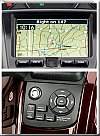 Garmin International Inc. announced that it is now serving as a tier-one automotive OEM supplier with its newly-developed modular GPS navigation system on the 2006 Honda Gold Wing motorcycle. "This marks the first time that Garmin has provided a vehicle manufacturer with a factory installed navigation system," said Gary Kelley, Garmin's vice president of marketing. "The Gold Wing is Honda's premier touring bike, and navigating the highways and byways just got a lot easier now that Garmin is on board." Known as the Honda Satellite Linked Navigation System, it provides complete North American mapping with nearly six million points of interest displayed on a large seven-inch integrated display. -- Posted Thursday, September 29, 2005
Garmin International Inc. announced that it is now serving as a tier-one automotive OEM supplier with its newly-developed modular GPS navigation system on the 2006 Honda Gold Wing motorcycle. "This marks the first time that Garmin has provided a vehicle manufacturer with a factory installed navigation system," said Gary Kelley, Garmin's vice president of marketing. "The Gold Wing is Honda's premier touring bike, and navigating the highways and byways just got a lot easier now that Garmin is on board." Known as the Honda Satellite Linked Navigation System, it provides complete North American mapping with nearly six million points of interest displayed on a large seven-inch integrated display. -- Posted Thursday, September 29, 2005
Sony Aibo: old dog learns new tricks
 We've reveiwed the whimsical, yet future-oriented Sony AIBO robo dog a couple of times. It recognizes faces and voices, expresses emotion through its face lights and even connects remotely to the Internet so you can keep in touch with it from anywhere. Now with Mind 3 software on board, AIBO is supposedly more engaging, entertaining and interactive than ever. According to Sony, AIBO can now blog its own photo diary and read out website content aloud. AIBO remembers the location of its items and its favourite place. Simple dialogue with AIBO is now possible with AIBO responding with spoken words. You can connect with AIBO over the Internet and navigate it or take pictures from anywhere in the world. -- Posted Thursday, September 29, 2005
We've reveiwed the whimsical, yet future-oriented Sony AIBO robo dog a couple of times. It recognizes faces and voices, expresses emotion through its face lights and even connects remotely to the Internet so you can keep in touch with it from anywhere. Now with Mind 3 software on board, AIBO is supposedly more engaging, entertaining and interactive than ever. According to Sony, AIBO can now blog its own photo diary and read out website content aloud. AIBO remembers the location of its items and its favourite place. Simple dialogue with AIBO is now possible with AIBO responding with spoken words. You can connect with AIBO over the Internet and navigate it or take pictures from anywhere in the world. -- Posted Thursday, September 29, 2005
OQO announces improved model 01+
Enhanced Ultra Personal Computer Comes
 OQO announces the OQO model 01+ with 512MB RAM, 30GB Hard Drive, USB 2.0, internal Speaker, improved Pen-Based digitizer, Car/Auto ChargerWith upgraded specs, new features and additional accessories all packed in the same 14 ounce pocketable design that made the model 01 the smallest and most mobile Windows XP computer on the market. The model 01+ starts at US$1,899; the original remains available for US$1,499. Our take: We'll be most interested in reviewing the new digitizer implementation as this was a real problem with the original model 01. The at times anemic processor apparently remains the same. -- Posted Tuesday, September 27, 2005
OQO announces the OQO model 01+ with 512MB RAM, 30GB Hard Drive, USB 2.0, internal Speaker, improved Pen-Based digitizer, Car/Auto ChargerWith upgraded specs, new features and additional accessories all packed in the same 14 ounce pocketable design that made the model 01 the smallest and most mobile Windows XP computer on the market. The model 01+ starts at US$1,899; the original remains available for US$1,499. Our take: We'll be most interested in reviewing the new digitizer implementation as this was a real problem with the original model 01. The at times anemic processor apparently remains the same. -- Posted Tuesday, September 27, 2005
iAnywhere launches 'RFID Insider' site for RFID Developers
Sybase subsidiary iAnywhere announced the launch of a new web-based resource center, RFID Insider, for RFID developers. The site aims to deliver the software, tools, and educational content necessary to advance RFID development capabilities in the market and bring them to the mainstream. -- Posted Tuesday, September 27, 2005
Charcoal JAM - cool and twice the RAM
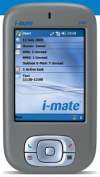 i-mate USA announced the launch of the i-mate Charcoal JAM mobile phone for the U.S. market. The Charcoal JAM includes all the advanced Windows Mobile features of the i-mate JAM but has twice the built-in memory at 128 MB. The new i-mate Charcoal JAM retains the same design and compact dimensions of the original JAM, which is the slimmest Pocket PC on the market, but comes in a distinguished charcoal color. The i-mate Charcoal JAM has a suggested retail price of $665. The original i-mate JAM will continue to be available at a suggested retail price of $649. -- Posted Tuesday, September 27, 2005
i-mate USA announced the launch of the i-mate Charcoal JAM mobile phone for the U.S. market. The Charcoal JAM includes all the advanced Windows Mobile features of the i-mate JAM but has twice the built-in memory at 128 MB. The new i-mate Charcoal JAM retains the same design and compact dimensions of the original JAM, which is the slimmest Pocket PC on the market, but comes in a distinguished charcoal color. The i-mate Charcoal JAM has a suggested retail price of $665. The original i-mate JAM will continue to be available at a suggested retail price of $649. -- Posted Tuesday, September 27, 2005
Symbol and BARTEC unveil explosion-protected handheld
Symbol Technologies announced a partnership with BARTEC, a provider of products and services for hazardous environments, to deliver explosion-protected versions of Symbol MC9000 ruggedized mobile computers. Designed for deployment in hazardous industrial locations where flammable gases may be present, the MC9060-G and MC9060-K mobile computers deliver increased productivity and improved operational efficiencies for customers in the environmental protection, chemical, oil, pharmaceutical, natural gas, plant engineering, transportation and energy industries. -- Posted Tuesday, September 27, 2005
THEY DID IT!!!!
After months' of denying it, the once unthinkable happened: "Palm, Microsoft and Verizon Wireless have just announced a partnership to bring Windows Mobile to the Treo smartphone. The new smartphone provides customers with more options and will be available beginning early next year." [Read full press release]
Now all that remains to be done is speculating what it all will mean. The idea behind the original Palm was to offer a blindingly fast, yet totally simple way to carry and access data. Longtime Pen Computing Magazine readers may recall Jeff Hawkins' words in our interviews with him. He predicted Windows CE devices becoming ever more complex, something that he really didn't want to have any part of. Apparently complexity won over simplicity. Or perhaps it was simply Microsoft grinding away at, and finally once again prevailing over what is, or rather once was, a better solution. -- Posted Monday, September 26, 2005
Trimble T-Ticket mobile citation software
Ouch! At Pen Computing Magazine we like fast cars. Good thing we only speed at the track, or else we may get a first-hand look at Trimble's new T-Ticket Mobile Citation Software. Designed to seamlessly integrate with Trimble's rugged Windows CE-based Trimble Recon handheld computer, the officer follows a series of simple screens to enter details on the violation. The officer then prints the ticket via a Bluetooth wireless printer. Once the citation is complete, T-Ticket wirelessly updates the police database with the electronic citation information, generating statistics and compiling reports that accurately reflect the citation activity in a specified area or time period. -- Posted Monday, September 26, 2005
AppForge to support BlackBerry
AppForge, long among our favorite mobile application software smithies, announced plans to support BlackBerry in its Crossfire development system. While other solutions may require a server-based system that transcodes web-based or ASP applications, Crossfire applications will be fully local on the BlackBerry. AppForge will be the first company to offer this type of comprehensive development solution to the market. At Pen Computing we've used BackBerries since Day 1 and we applaud AppForge for extending support to the platform! [see release] -- Posted Monday, September 26, 2005
Palm-based wireless sensing system
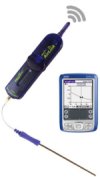 ImagiWorks announced its ImagiProbe Wireless Sensing System ships to schools today, and Orange County Public Schools in Orlando, Florida, the 12th largest school district in the nation, is among the first to get the new Bluetooth data collection tool designed to engage students in scientific exploration and discovery by allowing them to easily collect and visually analyze data. ImagiLabs for ImagiProbee kits include a variety of "SensorScience" discovery activities. The data collection system is used with Palm Powered (Palm OS 5.0 or higher) handheld computers and devices. -- Posted Monday, September 26, 2005
ImagiWorks announced its ImagiProbe Wireless Sensing System ships to schools today, and Orange County Public Schools in Orlando, Florida, the 12th largest school district in the nation, is among the first to get the new Bluetooth data collection tool designed to engage students in scientific exploration and discovery by allowing them to easily collect and visually analyze data. ImagiLabs for ImagiProbee kits include a variety of "SensorScience" discovery activities. The data collection system is used with Palm Powered (Palm OS 5.0 or higher) handheld computers and devices. -- Posted Monday, September 26, 2005
Intellisync Unified Messaging
Intellisync, known for its platform-independent wireless messaging and mobile software, introduced "Intellisync Unified Messaging" for mobile devices. Intellisync Unified Messaging makes any type of mobile communication -- email, voice, text or instant message -- accessible on a single interface on any device in any location, with "One-Touch" access. The goal here is to increase productivity and user satisfaction with wireless communications for mobile professionals, large enterprises and wireless carriers. Intellisync Unified Messaging also provides an enterprise-ready, carrier-grade wireless email and instant messaging platform that will enable IT managers and mobile operators to provide users with seamless access to business and personal communications on mobile devices. -- Posted Monday, September 26, 2005
Handmark Pocket Express Version 2.0
Mobile media publisher Handmark announced Version 2.0 of its award-winning Pocket Express suite of wireless content services for cell phones, smartphones, and wireless PDAs. The new rev adds an attractive new "Tuxedo" interface, location-based services, more news and photos, real-time sports scores, and improved mapping features, all accessible from a central "PageOne" screen. -- Posted Monday, September 26, 2005
HP launches new and enhanced iPAQs
HP announced a new iPAQ, the rx1950 series Pocket PC, and enhanced iPAQ hx2000 series Pocket PC, and Windows Mobile 5.0 upgrades for select iPAQs. The upgraded 2000 Series models are the hx2190 (US$349), hx 2490 (US$399) and hx2790 (US$499) which all replace prior 2100/2400/2700 models. The primary difference seems to be Windows Mobile 5.0 and a price that's lower by US$50 for all models. The US$299 iPAQ rx1950 is a new model that brings integrated WiFi to the lower end of the iPAQ spectrum. Also announced was a US$39 Windows Mobile 5.0 upgrade for the hx2000 series. -- Posted Monday, September 26, 2005
Dell Axim X51v -- worth it?
While we always felt the HP iPAQ 4700 was the champion of the glorious 480x640 resolution Pocket PCs, Dell did a credible job with the Axim X50v, the little "v" indicating that this was an Axim with a VGA display as opposed to the dinky 240x320 screens of other X50 models. However, the X50v had mediocre battery life and was a bit sluggish in its graphics performance. So what's the deal with the just released X51v? It's essentially the same machine, but has 256MB of Flash ROM (twice as much as the X50v) and comes with Windows Mobile 5. That's about it. Given that you can upgrade the X50v to WinMo 5, the extra $100 Dell charges for the new model may be a big much, but that may well come down in time. Anyway, kudos to Dell for being first with WinMo 5. -- Posted Friday, September 23, 2005
Navman releases new GPS-enabled Pocket PC
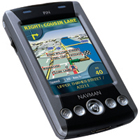 Navman, a designer and manufacturer of GPS, communication and marine products, announced an addition to its line of navigation products for the consumer electronics market. The Personal Interactive Navigator (PiN) 570 combines a GPS receiver with a Pocket PC. The Windows Mobile 2003-based Navman PiN 570 has a 3.5-inch 240x320 transflective LCD touchscreen, a Samsung 266MHz processor, and 64MB of internal RAM. Tele Atlas map data is stored on a supplied 128MB memory card and accessed through the device's SDIO MMC/SD slot. The device uses Navman's SmartST 2005 mapping software that provides turn-by-turn instructions, several map views, trip planner, POIs, etc. The Navman PiN 570 is available at electronics stores nationwide for U.S. $499.95. Our take: the good news is that GPS-equipped Pocket PCs seem to be one of the few PDA growth areas. The not-so-good news is that the hardware is almost always underpowered and nearly obsolete. Why not go all the way and offer a state-of-the-art machine? It'd still be less expensive than an in-dash system by far. -- Posted Wednesday, September 21, 2005
Navman, a designer and manufacturer of GPS, communication and marine products, announced an addition to its line of navigation products for the consumer electronics market. The Personal Interactive Navigator (PiN) 570 combines a GPS receiver with a Pocket PC. The Windows Mobile 2003-based Navman PiN 570 has a 3.5-inch 240x320 transflective LCD touchscreen, a Samsung 266MHz processor, and 64MB of internal RAM. Tele Atlas map data is stored on a supplied 128MB memory card and accessed through the device's SDIO MMC/SD slot. The device uses Navman's SmartST 2005 mapping software that provides turn-by-turn instructions, several map views, trip planner, POIs, etc. The Navman PiN 570 is available at electronics stores nationwide for U.S. $499.95. Our take: the good news is that GPS-equipped Pocket PCs seem to be one of the few PDA growth areas. The not-so-good news is that the hardware is almost always underpowered and nearly obsolete. Why not go all the way and offer a state-of-the-art machine? It'd still be less expensive than an in-dash system by far. -- Posted Wednesday, September 21, 2005
Pocket PC Phone: Trying every form factor
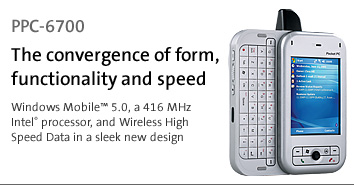 The search for the ultimate form factor for Pocket PC Phones continues. Obviously they can never be quite as small and sleek as the latest cellphones because they have more functionality, power, and a much bigger screen. Then there's the pesky need to offer both a phone keypad and a reasonably useful keyboard. Many find thumbtyping acceptable, others find the tiny keyboards too small. So let's offer a bigger one, one that slides out sideways. Those who've seen the tiny OQO Windows machine know the trick. Enter the device that makes its entrance onto the US market as the Sprint PPC-6700. It is a CDMA Windows Mobile 5.0 device with a 416MHz XScale chip, Bluetooth, WiFi, megapixel digicam, a size of 4.25 x 2.3 x 1 inches, a weight of 6.1 ounces. List price is $629.99, but considerably less with service plans. [see Sprint listing of device] -- Posted Tuesday, September 20, 2005
The search for the ultimate form factor for Pocket PC Phones continues. Obviously they can never be quite as small and sleek as the latest cellphones because they have more functionality, power, and a much bigger screen. Then there's the pesky need to offer both a phone keypad and a reasonably useful keyboard. Many find thumbtyping acceptable, others find the tiny keyboards too small. So let's offer a bigger one, one that slides out sideways. Those who've seen the tiny OQO Windows machine know the trick. Enter the device that makes its entrance onto the US market as the Sprint PPC-6700. It is a CDMA Windows Mobile 5.0 device with a 416MHz XScale chip, Bluetooth, WiFi, megapixel digicam, a size of 4.25 x 2.3 x 1 inches, a weight of 6.1 ounces. List price is $629.99, but considerably less with service plans. [see Sprint listing of device] -- Posted Tuesday, September 20, 2005
Acer unveils C200 convertible w/o "the twist"
One of the huge annoyances with all current Tablet PC convertibles is the twist/swivel hinge that looks great, works well, but also means the display is flexing so much when you tap the display with the pen as to render it nearly useless. Everyone has used this design since Microsoft reinvented the pen computer back in 2002, starting with Acer's own C100. That is peculiar as at least five design solutions exist (we showed and explained them all in Pen Computing Magazine).
So now Acer showed a new Tablet PC convertible machine that uses a more sensible design, one where the display opens conventionally. You can then slide the bottom of the display forward on rails, with the back of it being supported, making for a much more stable solution. IBM used a variant of this in its early ThinkPad convertibles, the P750 and then the P360. [see images of the new design]. Those who remember the Vadem Clio will also find this design familiar.
In terms of specs, the C200, which will come in C202 and C204 versions, uses either a Pentium 1.73GHz M740 or a 2.0GHz M760, the Intel 915GM/915PM chipset, 512 or 1gb of DDR-2 RAM, Nvidia GeForce Go 6200 with 64MB of VRAM, gigabit Ethernet, BT, Firewire, a 4-in-1 card reader, a PC Card slot, 3 USB 2.0, IR, modem, and an optical drive. The display is a standard 12.1 inch 1024x768. -- Posted Monday, September 19, 2005
Psion Teklogix handheld selected by US DoD
Psion Teklogix, a global provider of solutions for mobile computing, wireless data collection, imaging and RFID, today announced that its rugged EPC-compliant 7535 Hand-Held Computer with RD7950 Integrated UHF RFID Reader has been the only hand-held reader selected for use by the U.S. Department of Defense (DoD), U.S. Coast Guard and several other federal agencies. Psion Teklogix partners CDO Technologies, SYS-TEC and WFI have each been awarded a Blanket Purchase Agreement from the Army Contracting Agency Information Technology, E-Commerce, and Commercial Contracting Center. Psion Teklogix has more than 400 government installations worldwide, and a Government Solutions Group supporting its Department of Defense and Federal Agency customer base. -- Posted Friday, September 16, 2005
Fujitsu will offer diminutive P1500 with Tablet PC Edition
Fujitsu Computer Systems announced that its ultra-portable LifeBook P1500 notebook convertible will become available with Windows XP Tablet PC Edition starting in October. The P1500 has a 8.9-inch WSVGA wide-format display and has a footprint considerably smaller than other TPC notebook convertibles. Pricing will start at US$1,549. We initially thought the product was Asian markets only, but then Fujitsu offered it in the US, but with just a touchscreen and standard Windows XP Professional. -- Posted Wednesday, September 14, 2005
Unova to change name to Intermec
There was a time when Intermec was just a subsidiary of Unova, and sort of a stepchild at that. Then Intermec stepped up to bat and, under the dynamic leadership of Larry Brady, established itself as a successful and driving force in the mobile/wireless industrial market. I've had the pleasure to attend one of Brady's visionary presentations at the 2003 Intermec conference and then speak to him in social settings, coming away more than impressed. So we're not surprised that Unova's board of directors decided to change its name to Intermec, Inc. effective January 1, 2006, with Larry Brady at the helm. -- Posted Tuesday, September 13, 2005
Symbol and Intermec make nice. For now.
When it comes to scanners, barcodes and wireless systems for tracking inventory, nobody does it better than Symbol Technologies and Intermec. Much is at stake here with RFID coming on strong, and so it was no surprise when the two feisty competitors went at each other in an intellectual property dispute. Fortunately, reason has prevailed, for now, and the two announced that pending and anticipated legal action was on hold and they'd try to resolve their differences regarding intellectual property issues. As part of the kiss-and-make-up, Symbol joined Intermecs Rapid Start RFID intellectual property licensing program, and agreed to cross-license its own RFID patents with those of Intermec. [see joint release] [see participants in Intermec's RFID Rapid Start Licensing Program] -- Posted Tuesday, September 13, 2005
PalmSource sale won't affect existing customers
According to an article in news.com, the sale of PalmSource to Japan's Access won't have an immediate impact on Palm owners as existing versions of the OS will continue to be supported. Access said it also wants to complete a Linux/Palm OS hybrid that was already in progress. The eventual goal is to combine the Linux-based Access NetFront browser with Palm version 5x (Garnet) and might also use version 6 (Cobalt) -- Posted Tuesday, September 13, 2005
Cingular certifies rugged Intermec mobile computer for voice and data
Intermec's 700-Series of rugged handheld computers, its most successful handheld of all time with over 300,000 sold and a former recipient of Pen Computing's Editor's Choice Award as Best Advanced Industrial PDA, has been around for a while. However, the company has kept it technologically up-to-date and the device is available in numerous configurations. One of them, the 761, has now been approved for voice and data transmission via GSM/GPRS on the Cingular Wireless network, the largest wireless digital voice and data network in the United States. With this certification, Cingular customers now can use an Intermec 761 handheld computer to make voice calls, send data and manage documents. The 761 also operates in the 850MHz band, providing increased coverage and network availability, and employs Microsoft Windows Mobile 2003 Phone Edition software for enhanced, telephone-like operation. -- Posted Monday, September 12, 2005
PalmSource bought by Japanese company
PalmSource agreed to be bought by Access Co. Ltd., a Tokyo-based provider of mobile content delivery software, including the NetFront mobile browser. Access will pay US$324 million, or US$18,50 per share (PalmSource stock was at just $10 yesterday). Interim PalmSource CEO Patrick McVeigh said "We believe the customer and technology synergies of the combined companies will open up new market opportunities for both companies worldwide." Access says it expects the deal to expand its product line and geographic reach, giving it operating system platform expertise and Linux development resources for mobile devices in the U.S., France and China. Palm CEO Ed Colligan said Access is currently a Palm software technology partner. Reuters made the following interesting statement: "PalmSource developed the Palm software used in devices made by gadget makers including Palm, Sony, Kyocera and Samsung." PalmSource, of course, had bought China MobileSoft (and some of its executives with experience that went way back to the beginning of pen computing), a company that specialized in Chinese mobile Linux, so ownership by Access might accelerate a move to Linux and penetration into large Asian markets. What will it all mean? Japanese ownership seems to indicate a Palm OS move towards Linux rather than Windows Mobile (though NetFront is available for Widows Mobile). And it's hard to see what will happen to Palm, Inc., now that its own OS is owned by a Japanese company. -- Posted Friday, September 9, 2005
Gateway launches new Tablet PC convertible
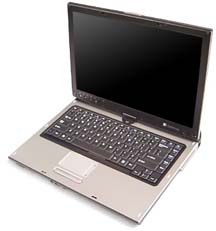 Gateway, whose M275 notebook convertible has had sort of a low-key career, has introduced the Gateway M280 notebook convertible. The most distinguishing feature of the new model is a 14-inch wide format screen with 1280 x 768 pixels. There is a choice of either a 1.86GHz Pentium M750 or a 1.4GHz Celeron M360. 5400rpm hard disks of 40, 60, or 80MB are available, as are various optical drive options. The machine is fairly large (13.6 x 10.25 x 1.36) and heavy (6.75 pounds), making it primarily suitable for desktop use. Like the M275, the new model has a multi-format card reader that now can also read Memory Stick/Pro. On the video side there is a choice between an ATI Radeon X600 and Intel 915GMS circuitry. Memory (DDR2/533MHz) goes up to 2GB. A powerful 75 Watt-Hour battery suggests more than adequate battery life. For specs, click here. -- Posted Wednesday, September 7, 2005
Gateway, whose M275 notebook convertible has had sort of a low-key career, has introduced the Gateway M280 notebook convertible. The most distinguishing feature of the new model is a 14-inch wide format screen with 1280 x 768 pixels. There is a choice of either a 1.86GHz Pentium M750 or a 1.4GHz Celeron M360. 5400rpm hard disks of 40, 60, or 80MB are available, as are various optical drive options. The machine is fairly large (13.6 x 10.25 x 1.36) and heavy (6.75 pounds), making it primarily suitable for desktop use. Like the M275, the new model has a multi-format card reader that now can also read Memory Stick/Pro. On the video side there is a choice between an ATI Radeon X600 and Intel 915GMS circuitry. Memory (DDR2/533MHz) goes up to 2GB. A powerful 75 Watt-Hour battery suggests more than adequate battery life. For specs, click here. -- Posted Wednesday, September 7, 2005
6 and 8GB Microdrives soon available
Hitachi Global Storage Technologies will start shipping larger Microdrives soon, probably the 4th quarter of 2005. Carrying the cutesy codename "Mikey," the new Microdrives will have storage capacities of 6-8GB and will primarily be targeted to portable multimedia players (hello larger capacity iPod Mini!), MP3 players and handsets. Hitachi sold 4.4 million Microdrives in the first half of 2005. -- Posted Wednesday, September 7, 2005
Philips "rollable" display
Philips Polymer Vision is showing a prototype of a rollable 5-inch 320x240 display that uses a bi-stable electrophoretic display effect from E-Ink. Once the user is done, the display rolls back into a 4 x 2.4 x 0.8 inch housing. The prototype is based on Philips' PV-QML5 rollable display reference design, and is simply meant to elicit customer feedback for now. -- Posted Friday, September 2, 2005
First workshop on Tablet PCs in education
A couple of years ago, we published an article by Dr. Dave Berque of DePauw University on pen computing in education. Dr. Berque and several others involved in pen computing are putting together the first Workshop on the Impact of Pen-based Technology on Education (WIPTE).
Organized by representatives from DyKnow, HP, Microsoft, and several notable educational institutions, WIPTE will be held April 6-7, 2006, at Purdue University. WIPTE will bring together educators and technologists using Tablet PCs and other pen-based technologies in the teaching and learning environment.
To date, there has been no venue for sharing and disseminating the value of pen-based computer technology as it cuts across a variety of educational disciplines, grade levels, and settings. In an effort to address this need, WIPTE seeks submissions from individuals with experience deploying pen-based pedagogy in varied educational environments. Paper submissions are due November 1, 2005. Read the call for proposals and get more information at http://www.purdue.edu/wipte. -- Posted Thursday, September 1, 2005
 Garmin International Inc. announced that it is now serving as a tier-one automotive OEM supplier with its newly-developed modular GPS navigation system on the 2006 Honda Gold Wing motorcycle. "This marks the first time that Garmin has provided a vehicle manufacturer with a factory installed navigation system," said Gary Kelley, Garmin's vice president of marketing. "The Gold Wing is Honda's premier touring bike, and navigating the highways and byways just got a lot easier now that Garmin is on board." Known as the Honda Satellite Linked Navigation System, it provides complete North American mapping with nearly six million points of interest displayed on a large seven-inch integrated display. -- Posted Thursday, September 29, 2005
Garmin International Inc. announced that it is now serving as a tier-one automotive OEM supplier with its newly-developed modular GPS navigation system on the 2006 Honda Gold Wing motorcycle. "This marks the first time that Garmin has provided a vehicle manufacturer with a factory installed navigation system," said Gary Kelley, Garmin's vice president of marketing. "The Gold Wing is Honda's premier touring bike, and navigating the highways and byways just got a lot easier now that Garmin is on board." Known as the Honda Satellite Linked Navigation System, it provides complete North American mapping with nearly six million points of interest displayed on a large seven-inch integrated display. -- Posted Thursday, September 29, 2005 We've reveiwed the whimsical, yet future-oriented Sony AIBO robo dog a couple of times. It recognizes faces and voices, expresses emotion through its face lights and even connects remotely to the Internet so you can keep in touch with it from anywhere. Now with Mind 3 software on board, AIBO is supposedly more engaging, entertaining and interactive than ever. According to Sony, AIBO can now blog its own photo diary and read out website content aloud. AIBO remembers the location of its items and its favourite place. Simple dialogue with AIBO is now possible with AIBO responding with spoken words. You can connect with AIBO over the Internet and navigate it or take pictures from anywhere in the world. -- Posted Thursday, September 29, 2005
We've reveiwed the whimsical, yet future-oriented Sony AIBO robo dog a couple of times. It recognizes faces and voices, expresses emotion through its face lights and even connects remotely to the Internet so you can keep in touch with it from anywhere. Now with Mind 3 software on board, AIBO is supposedly more engaging, entertaining and interactive than ever. According to Sony, AIBO can now blog its own photo diary and read out website content aloud. AIBO remembers the location of its items and its favourite place. Simple dialogue with AIBO is now possible with AIBO responding with spoken words. You can connect with AIBO over the Internet and navigate it or take pictures from anywhere in the world. -- Posted Thursday, September 29, 2005 OQO announces the
OQO announces the  i-mate USA announced the launch of the
i-mate USA announced the launch of the 

 The search for the ultimate form factor for Pocket PC Phones continues. Obviously they can never be quite as small and sleek as the latest cellphones because they have more functionality, power, and a much bigger screen. Then there's the pesky need to offer both a phone keypad and a reasonably useful keyboard. Many find thumbtyping acceptable, others find the tiny keyboards too small. So let's offer a bigger one, one that slides out sideways. Those who've seen the tiny OQO Windows machine know the trick. Enter the device that makes its entrance onto the US market as the Sprint PPC-6700. It is a CDMA Windows Mobile 5.0 device with a 416MHz XScale chip, Bluetooth, WiFi, megapixel digicam, a size of 4.25 x 2.3 x 1 inches, a weight of 6.1 ounces. List price is $629.99, but considerably less with service plans. [
The search for the ultimate form factor for Pocket PC Phones continues. Obviously they can never be quite as small and sleek as the latest cellphones because they have more functionality, power, and a much bigger screen. Then there's the pesky need to offer both a phone keypad and a reasonably useful keyboard. Many find thumbtyping acceptable, others find the tiny keyboards too small. So let's offer a bigger one, one that slides out sideways. Those who've seen the tiny OQO Windows machine know the trick. Enter the device that makes its entrance onto the US market as the Sprint PPC-6700. It is a CDMA Windows Mobile 5.0 device with a 416MHz XScale chip, Bluetooth, WiFi, megapixel digicam, a size of 4.25 x 2.3 x 1 inches, a weight of 6.1 ounces. List price is $629.99, but considerably less with service plans. [ Gateway, whose M275 notebook convertible has had sort of a low-key career, has introduced the Gateway M280 notebook convertible. The most distinguishing feature of the new model is a 14-inch wide format screen with 1280 x 768 pixels. There is a choice of either a 1.86GHz Pentium M750 or a 1.4GHz Celeron M360. 5400rpm hard disks of 40, 60, or 80MB are available, as are various optical drive options. The machine is fairly large (13.6 x 10.25 x 1.36) and heavy (6.75 pounds), making it primarily suitable for desktop use. Like the M275, the new model has a multi-format card reader that now can also read Memory Stick/Pro. On the video side there is a choice between an ATI Radeon X600 and Intel 915GMS circuitry. Memory (DDR2/533MHz) goes up to 2GB. A powerful 75 Watt-Hour battery suggests more than adequate battery life. For specs,
Gateway, whose M275 notebook convertible has had sort of a low-key career, has introduced the Gateway M280 notebook convertible. The most distinguishing feature of the new model is a 14-inch wide format screen with 1280 x 768 pixels. There is a choice of either a 1.86GHz Pentium M750 or a 1.4GHz Celeron M360. 5400rpm hard disks of 40, 60, or 80MB are available, as are various optical drive options. The machine is fairly large (13.6 x 10.25 x 1.36) and heavy (6.75 pounds), making it primarily suitable for desktop use. Like the M275, the new model has a multi-format card reader that now can also read Memory Stick/Pro. On the video side there is a choice between an ATI Radeon X600 and Intel 915GMS circuitry. Memory (DDR2/533MHz) goes up to 2GB. A powerful 75 Watt-Hour battery suggests more than adequate battery life. For specs,